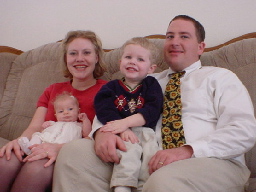| Research supports that children who grow up in households with two continuously married parents are less likely to experience a wide range of problems. |  |
During the last 30 years family dynamics in the United States have changed drastically. In 1970 singe parent families made up only 12% of the population. By 2003 this percent has increased to 26%. Currently it is expected that half of the children born today will spend
some part of their childhood in a single parent family.
This change in family dynamics has been studied by many researchers, especially as juvenile delinquency and suicide rates in children and teens has also risen over the last thirty years. Researchers wanted to know if there was a direct correlation between the two. The evidence says yes.
Findings overwhelmingly support that the best environment to raise children is in a two-parent family, where the parents are married. Of course not every two-parent family is ideal, and sometimes children are better off in a single parent home, but this is the exception not the rule.
Professor Paul Amato of Pennsylvania State University recently published his findings, of his investigation of numerous research studies, in an article titled, “The Impact of Family Formation Change on the Cognitive, Social, and Emotional Well-Being of the Next Generation.”
He wanted to know the differences between children raised in two-parent households versus one-parent households. He found that children who grow up in households with two continuously married parents are less likely to experience a wide range of problems.
Children from single parent families have “more behavioral problems, more emotional problems, and lower levels of school engagement (that is, caring about school and doing homework).”
The reasons are simple children who grow up in stable two-parent families have a higher standard of living. Hence they “receive more effective parenting, experience more cooperative co-parenting, are emotionally closer to both parents, and are subjected to fewer stressful events and circumstances.”
Studies also revealed similar findings for children of divorced parents and cohabitating parents. The dissolution of marriage, and uncertainty of cohabitation are reflected in the child’s behavior and emotional state.
Even though divorce is now common, and 50% of marriages will end in divorce, children of divorced parents “continued to have lower average levels of cognitive, social, and emotional well-being.”
The effects of divorce continue into adulthood where they often attain “lower socioeconomic attainment”, as well as experience “lower psychological well-being, poorer marital quality, and an elevated risk of seeing their own marriage end in divorce.”
This does not mean that a parent should stay in an abusive relationship just so their children do not suffer the effects of divorce. Children whose parents do not have a stable marriage are better off in a single parent family.
It does mean that parents need to truly evaluate their reasons for divorce and see if differences can be worked through. Because research supports that children truly do benefit from growing up in a household with two continuously married parents.

